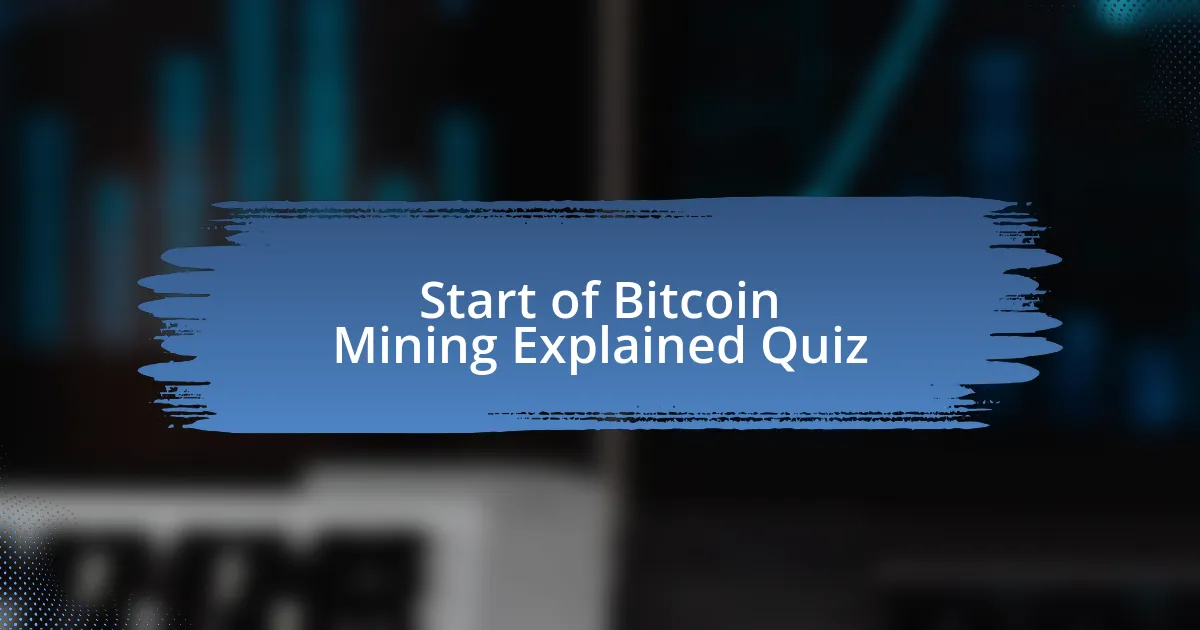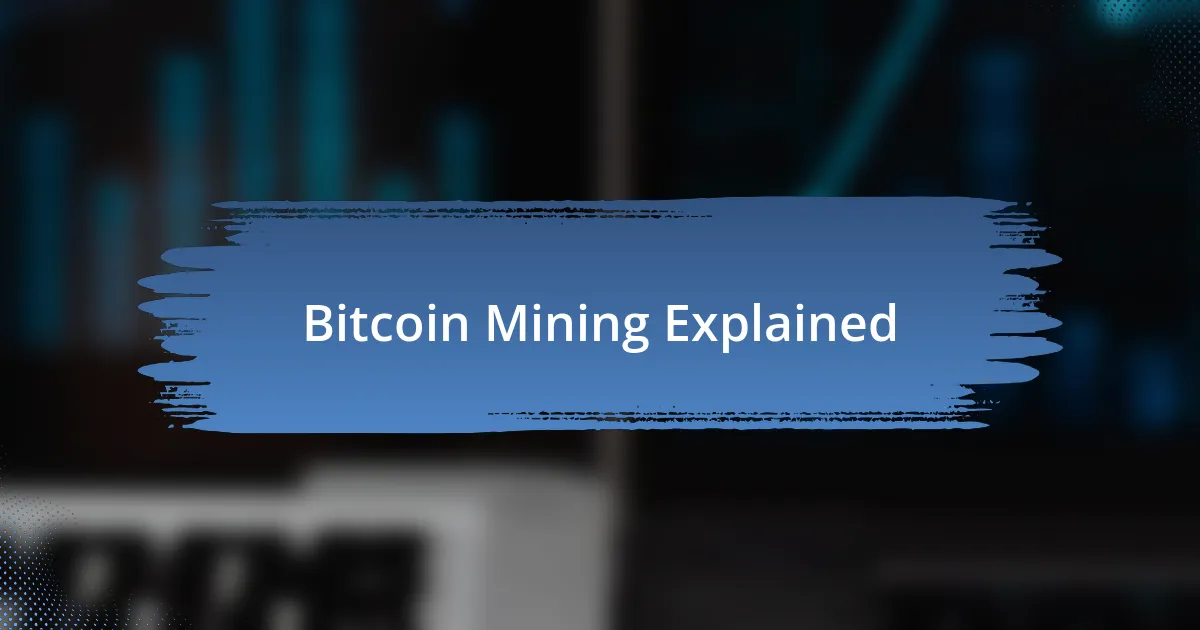
Start of Bitcoin Mining Explained Quiz
1. What is Bitcoin mining?
- A way to store Bitcoins securely in a digital wallet.
- An investment strategy to maximize Bitcoin returns quickly.
- A method of purchasing Bitcoin at lower prices in bulk.
- The process by which Bitcoin transactions are validated digitally on the Bitcoin network and added to the blockchain ledger.
2. What is the primary purpose of Bitcoin mining?
- To sell Bitcoins to users at a profit.
- To validate transactions and create new Bitcoins.
- To store Bitcoins safely on the network.
- To create new wallets for users on the blockchain.
3. What is the process of verifying new transactions against the Bitcoin network called?
- Bitcoin buying
- Bitcoin selling
- Bitcoin trading
- Bitcoin mining
4. How are new Bitcoins produced during the mining process?
- By cloning existing Bitcoins
- By purchasing them from the market
- By trading them with other cryptocurrencies
- By solving complex cryptographic hash puzzles to verify blocks of transactions
5. What is the attribute that stores the value of the hash of the previous block?
- Current hash
- Previous hash
- Block identifier
- Transaction hash
6. What is the aggregated set of transactions included in a block called?
- Ledger
- Value
- Data
- Block
7. What is the random value used to vary the output of the hash value called?
- Key
- Nonce
- Seed
- Flag
8. What is the digital signature of a block?
- Address
- Hash
- Data
- Value
9. What tools do bitcoin miners typically set up?
- Hardware (GPU, SSD, ASIC), mining software, a wallet, and a preferred mining pool
- Tablets, basic apps, a cloud service, and a personal account
- Laptops, printing tools, a manual, and a social network
- Desktop computers, standard software, a browser, and a random group
10. What is the process of generating a hash and appending another number to it called?
- Generating the data block
- Appending the nonce
- Creating a transaction log
- Solving the hash puzzle
11. How do miners solve the hash puzzle?
- By randomly generating hashes until one fits
- By using a predefined formula to create the hash
- By copying hashes from previous blocks to save time
- By finding the hash below a given target through the difficulty requirement
12. What is the target hash used for?
- To randomize the amount of Bitcoin awarded to miners.
- To determine mining difficulty based on the number of miners competing to solve a hash function.
- To create cryptocurrencies through random number generation.
- To establish transaction fees based on market demand.
13. How often is the mining difficulty adjusted?
- Every 2016 blocks, or roughly every two weeks
- Every day
- Every hour
- Every month
14. What happens when a miner successfully solves the hash puzzle?
- A miner loses all their invested resources.
- A new block is successfully created and validated in the Bitcoin network, and the transactions bundled in it are verified.
- The Bitcoin network shuts down temporarily.
- The miner is penalized for redundant calculations.
15. What is the reward given to the miner who solves the puzzle first?
- A share in the mining pool profits
- A fixed amount of cash payment
- A collectible digital token
- A reward in the form of Bitcoin and fees for the work done
16. How many Bitcoins are expected to be mined in total?
- 30 million
- 25 million
- 18 million
- 21 million
17. What happens to the mining process once all 21 million Bitcoins are circulating?
- The mining process is expected to cease, and miners will be rewarded through fees paid for the work done.
- All Bitcoin mining operations will stop completely worldwide.
- The Bitcoin network will become inactive and stop processing transactions.
- Miners will continue to receive new Bitcoin rewards for transactions.
18. What is the result of hashing a block of transactions?
- A timestamp of the transaction block
- A 64-digit hexadecimal number, or hash
- A binary file containing transaction data
- A simple text string representing transactions
19. What is the nonce used for in the mining process?
- To generate a hash and append another number to it.
- To manage the distribution of Bitcoin wallets.
- To calculate the total number of miners participating.
- To store the transaction fees in the blockchain.
20. How many attempts can a miner make before rolling over the nonce?
- About 2 billion attempts
- Nearly 10 billion attempts
- Roughly 1 million attempts
- Approximately 4.5 billion attempts
21. What is the extra nonce used for?
- To store previous transactions for future reference
- To generate a fixed hash for all blocks mined
- To provide a unique identifier for each transaction
- To roll over the nonce when it reaches its maximum value
22. How often does the Bitcoin network aim to produce one block?
- Every 10 minutes
- Every 5 minutes
- Every hour
- Every 15 minutes
23. How is the mining difficulty adjusted?
- Based on the number of participants and the average time it took to mine one block in the last period.
- By the temperature of the mining hardware and system performance.
- By the number of blocks mined in the previous hour or day.
- According to the market price of Bitcoin and trading volume.
24. What is the formula to calculate the blockchain`s creation rate?
- Block Reward + Network Size
- Block Size × Transaction Volume
- Block Time ÷ Block Reward
- Block Time – Block Reward
25. What is SHA-256?
- A type of computer virus affecting Bitcoin wallets.
- A secure hashing algorithm used by Bitcoin, originally designed by the NSA.
- A cryptocurrency used for online transactions.
- A programming language for software development.
26. What is a nonce?
- A number only used once, used to generate a hash and append another number to it
- A special type of cryptographic key
- A program for trading Bitcoin easily
- A kind of digital wallet for storing cryptocurrencies
27. How does crypto mining work?
- Miners verify transactions by manually checking each one against past records.
- Miners engage in a bidding war to win bitcoins from the network provider.
- Miners create simulations to imitate the blockchain`s operation for new coins.
- Miners compete to solve a mathematical puzzle encrypted within each block on the blockchain.
28. What is the role of crypto miners in verifying transactions?
- Miners create new coins by selling transactions to users for a profit.
- Miners store digital wallets that hold the cryptocurrencies for all users.
- Miners make sure each transaction is legitimate, ensuring that transactions are verified within minutes and visible for everyone to see.
- Miners randomly approve all transactions regardless of their validity.
29. What is the purpose of securing the network through crypto mining?
- To inflate the cryptocurrency`s market value artificially.
- To increase the availability of Bitcoin wallets for users.
- To eliminate the potential of double spending and secure the network.
- To create a central authority that oversees transactions.
30. What are the two well-known methods to validate crypto transactions?
- Proof of transaction and proof of wallet
- Proof of work and proof of stake
- Proof of block and proof of value
- Proof of chain and proof of system

Quiz Successfully Completed!
Congratulations on completing the quiz on ‘Bitcoin Mining Explained’! We hope you found the process engaging and informative. You have likely gained insights into how bitcoin mining works, the significance of miners in the network, and the various challenges they face. These aspects are crucial to understanding the broader context of cryptocurrency.
Throughout the quiz, you may have learned about important concepts like hash rates, mining pools, and the environmental impact of mining activities. Each question was designed to deepen your knowledge and challenge your understanding of the topic. Engaging with this quiz has equipped you with a clearer perspective on the complex world of bitcoin mining.
For those eager to expand their knowledge further, we invite you to explore the next section on this page. It contains in-depth information about ‘Bitcoin Mining Explained’. Dive deeper into the intricacies of mining technology, strategies, and its evolving role in the cryptocurrency ecosystem. Happy learning!

Bitcoin Mining Explained
What is Bitcoin Mining?
Bitcoin mining is the process of validating transactions on the Bitcoin network and adding them to the blockchain. Miners use specialized computers to solve complex mathematical problems, competing to find a new block. This process ensures that transactions are secure and prevents double spending. For each block mined, miners are rewarded with newly created bitcoins and transaction fees from the transactions included in that block.
How Bitcoin Mining Works
Bitcoin mining works through a consensus mechanism called Proof of Work. Miners collect pending transactions from the network and bundle them into a block. They then compete to solve a cryptographic puzzle. The first miner to solve the puzzle broadcasts the new block to the network. Other miners verify the solution and, if valid, the block is added to the blockchain, and the miner receives a reward. This process requires significant computational power and energy.
The Role of Miners in the Bitcoin Network
Miners play a critical role in maintaining the Bitcoin network’s integrity and security. They validate transactions, ensuring that only legitimate transactions are recorded. By solving cryptographic puzzles, they contribute to the decentralized nature of the network, preventing centralization and manipulation. Additionally, miners help stabilize the network by adjusting the difficulty level of the mining process based on total computational power.
Mining Hardware and Software
Mining requires specific hardware known as ASICs (Application-Specific Integrated Circuits) designed for the sole purpose of mining cryptocurrencies. These devices offer much higher efficiency than traditional CPUs or GPUs. In addition to hardware, miners need mining software that connects them to the Bitcoin network, manages their mining operations, and optimizes performance. Popular mining software includes CGMiner and BFGMiner.
Economic Factors Influencing Bitcoin Mining
The economics of Bitcoin mining are influenced by several factors, including the price of Bitcoin, mining difficulty, and operational costs, such as electricity and hardware maintenance. Higher Bitcoin prices can incentivize more mining, while increased mining difficulty reduces profit margins. Additionally, access to cheap energy can significantly impact mining profitability, as energy costs are one of the largest expenses for miners.
What is Bitcoin Mining?
Bitcoin mining is the process of validating and adding transactions to the Bitcoin blockchain. Miners use powerful computers to solve complex cryptographic puzzles, which secures the network and processes Bitcoin transactions. Upon successful completion of a puzzle, miners are rewarded with newly created bitcoins and transaction fees. As of 2023, the reward for mining one block is 6.25 bitcoins.
How does Bitcoin Mining work?
Bitcoin mining works by using a consensus algorithm called Proof of Work. Miners compete to solve a cryptographic problem associated with a block of transactions. The first miner to solve the problem broadcasts the solution to the network. Other miners verify the solution, and if accepted, the block gets added to the blockchain, securing and recording the transactions. This process also ensures the integrity of the Bitcoin network.
Where is Bitcoin Mining conducted?
Bitcoin mining is conducted globally, primarily in locations with access to cheap electricity. Regions such as China, Canada, and the United States have become hotspots for mining operations. Many miners set up large mining farms in these areas to take advantage of low energy costs. Data centers are often used to host mining equipment due to their efficient power management capabilities.
When did Bitcoin Mining begin?
Bitcoin mining began in January 2009, which was the same month that the Bitcoin network was created by an anonymous person or group known as Satoshi Nakamoto. The first block, known as the “genesis block,” was mined on January 3, 2009. At that time, the reward for mining a block was 50 bitcoins, reflecting the early stages of the Bitcoin ecosystem.
Who can participate in Bitcoin Mining?
Anyone can participate in Bitcoin mining as long as they have the necessary hardware and internet access. Initially, individual miners could mine Bitcoin using personal computers. However, as the network grew, mining became more competitive and resource-intensive. Now, most successful participants are part of mining pools or own specialized mining rigs designed for higher efficiency and performance.


